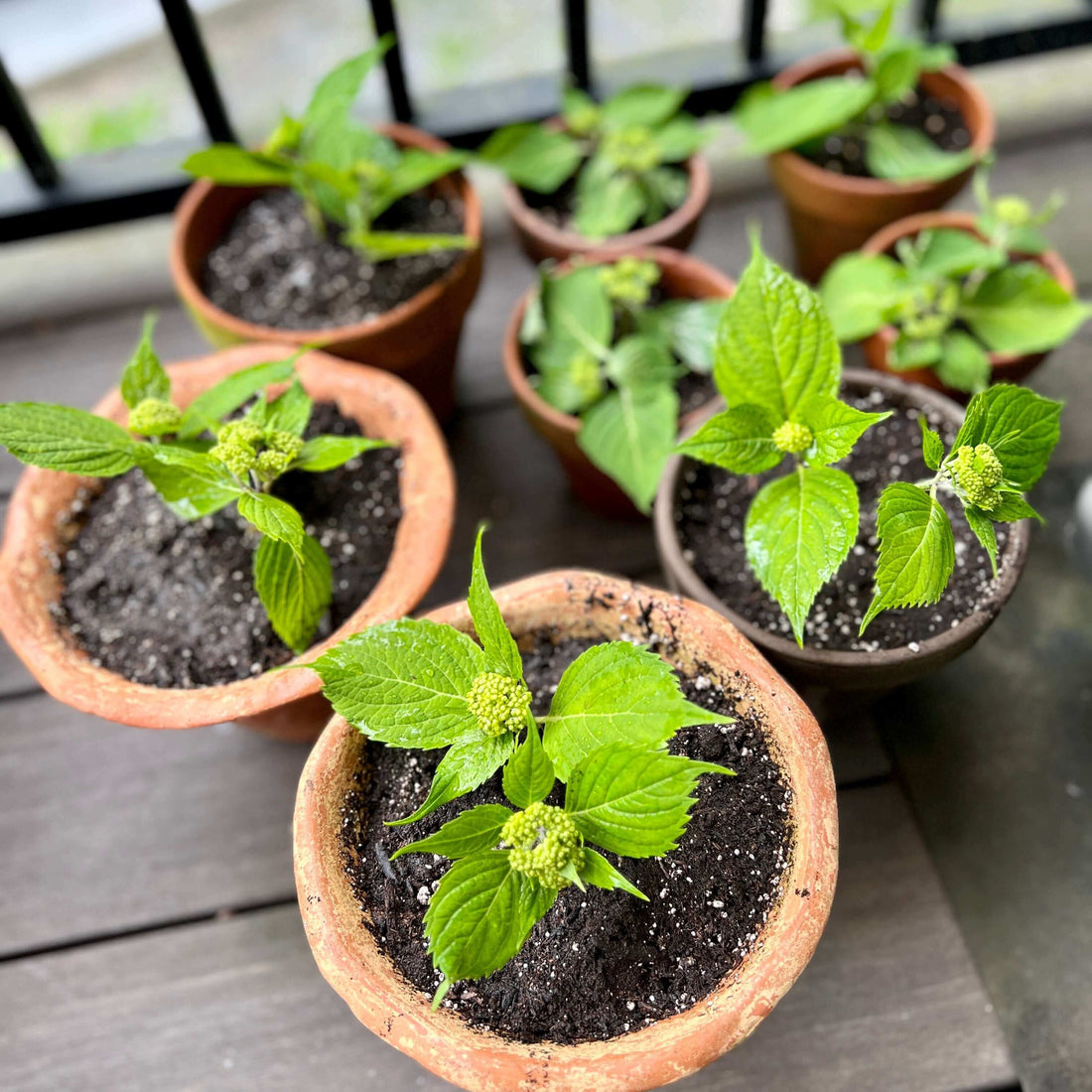
How to Propagate Hydrangeas with Bananas
Katherine Kelly
Hydrangeas are one of my garden favorites, known for their large, vibrant blooms and pops of color. They add a splash of color to any outdoor space. And are a big inspiration Lola & Gaia's collection of hydrangea prints...
Did you know you can propagate your own hydrangeas? Let's explore a unique method of hydrangea propagation. We'll use bananas, a common household item. Bananas are rich in potassium, a nutrient that aids in root development. This makes them an excellent tool for propagating hydrangeas. Whether you're a seasoned gardener or a beginner, this guide will walk you through the process. So, let's dive in and learn how to propagate hydrangeas with bananas.
Understanding Hydrangea Propagation
Propagation is a gardening technique used to create new plants from existing ones. It's a cost-effective way to increase the number of hydrangeas in your garden. In the case of hydrangeas, propagation is typically done using cuttings. This involves taking a piece of the plant, usually a stem or leaf, and encouraging it to develop its own roots. With the right care and conditions, this cutting will grow into a new hydrangea plant.
Why Use Bananas for Propagating Hydrangeas?
Bananas are a surprising yet effective tool for hydrangea propagation. They are rich in potassium, a nutrient that aids in root development. This makes them an excellent natural alternative to synthetic rooting hormones. Using bananas in your propagation process not only enhances root growth but also contributes to improved soil health. It's an organic method that reduces waste and avoids the use of synthetic chemicals.
Best Time for Taking Hydrangea Cuttings
The best time to take hydrangea cuttings is in late spring or early summer. This is when the plant is actively growing and the stems are flexible but not yet woody. Taking cuttings during this period increases the chances of successful propagation. It allows the cutting to establish roots before the colder months, ensuring a strong start for the new plant.
Selecting the Right Hydrangea Cutting
When selecting a cutting for hydrangea propagation, choose a healthy branch with new growth. The ideal cutting should be about 5-6 inches long and have several leaf nodes. Avoid branches that are too woody or too green. The cutting should be firm and not easily bent. This ensures that the cutting has the best chance of developing roots and growing into a healthy new hydrangea plant.
Preparing Your Banana for Hydrangea Propagation
To prepare your banana for hydrangea propagation, you'll need to chop it into small pieces or mash it. This makes it easier for the cutting to access the potassium and other nutrients in the banana.
Remember, the banana doesn't need to be ripe. In fact, using an overripe banana can attract pests, so it's best to use one that's just ripe or slightly underripe.

Step-by-Step Guide to Propagating Hydrangeas with Bananas
Now that you understand the basics of hydrangea propagation and the role of bananas, let's dive into the step-by-step process. This guide will walk you through each stage, from preparing your cutting to caring for your newly propagated hydrangeas.
Step 1: Cutting and Preparing the Stem
Start by selecting a healthy hydrangea stem with new growth. The stem should be about 5-6 inches long and not yet woody. Cut just below a leaf node, as this is where new roots will form. Remove the leaves near the bottom of the cutting. This exposes the nodes, which are crucial for root development. You can also soak your stems in a solution of rooting powder and water.


Step 2: Using the Banana
Next, take your prepared banana and place the hydrangea cutting into it. You can either insert the cutting into the center of the banana or bury the banana alongside the cutting in the soil. Remember, the banana serves as a natural source of potassium, which aids in root development.

Step 3: Planting the Cutting
Now it's time to plant your cutting. Choose a pot with well-draining soil rich in organic matter. Insert the cutting, with the banana, into the soil, ensuring the nodes are covered. The pot allows you to control the environment better during the early stages of propagation.

Step 4: Creating the Right Environment
Place the pot in a warm, bright location, but out of direct sunlight. Too much sun can scorch the cutting. Maintain consistent moisture in the soil, but avoid overwatering. Covering the pot with a plastic bag can create a greenhouse effect, helping to retain moisture and warmth.

Step 5: Caring for Your Propagated Cuttings
Finally, monitor your cuttings closely. Roots typically develop within 2-4 weeks, but it can take longer. Once roots have formed, gradually acclimate the cutting to outdoor conditions. Remember, patience is key. It's important to wait until the plant is well-established before transplanting it into the garden.
Aftercare: Ensuring Successful Hydrangea Growth
Once your hydrangea cutting has established roots, it's time to focus on aftercare. This involves gradually acclimating the plant to outdoor conditions. Start by placing the pot outside for a few hours each day, gradually increasing the time.
Remember, the location in your garden matters. Choose a spot with well-draining soil and partial shade. Hydrangeas prefer morning sun and afternoon shade. Regular watering and organic fertilizers can also help your new hydrangea plant thrive.
Troubleshooting Common Propagation Issues
Despite your best efforts, you may encounter some issues during hydrangea propagation. One common problem is the cutting wilting or turning brown. This could be due to overwatering or a lack of humidity.
Another issue could be the cutting not developing roots. This could be due to a lack of nutrients, which is where the banana comes in. If you're still having trouble, try using a fresh banana or adding more pieces to the soil.
FAQs on Propagating Hydrangeas with Bananas
Many gardeners have questions when it comes to propagating hydrangeas with bananas. Here are some of the most common queries:
Can I use any type of banana? Yes, any type of banana can be used. However, ripe bananas are often preferred due to their higher potassium content.
How long does it take for the cutting to root? It typically takes 2-4 weeks for the cutting to develop roots. However, this can vary depending on the conditions.
Can I use this method with other plants? Yes, this method can be used with other plants that propagate well from cuttings.
What should I do if my cutting isn't rooting? If your cutting isn't rooting, it may need more time. Alternatively, you could try using a fresh banana or adding more banana pieces to the soil.
Can I plant the cutting directly in the garden? It's best to start the cutting in a pot. This allows you to control the environment more effectively. Once the cutting has developed roots, it can be transplanted to the garden.
Patience and Care for Propagation Success
Propagating hydrangeas with bananas is a unique and organic method that can yield rewarding results. However, it's important to remember that patience and consistent care are key to successful propagation. With time and attention, you can cultivate beautiful hydrangeas from cuttings, contributing to a more sustainable and vibrant garden.
Follow us on Instagram...

2 comments
While bananas contain potassium, a beneficial nutrient for plants, using “banana juice” directly on hydrangeas is not the most effective method for providing potassium, as the nutrients aren’t readily available in that form. Instead, consider composting banana peels or using banana peel tea for a more effective way to provide potassium to your hydrangeas.
My hydrangeas are in the ground already. Can I stir up the soil and pour
The banana soup around the base.